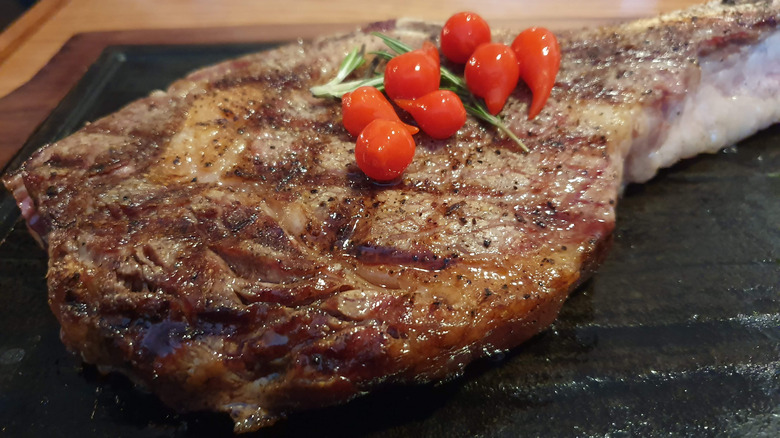The Reason Outback Steakhouse's Meat Is So Cheap
Outback Steakhouse's kitschy Australian theme and the steaks on its menu are the two pillars of its brand identity — both of which are front and center in the name. But while the chain restaurant is actually not nearly as Australian as you might think, its steaks really are a popular draw — along with the iconic Bloomin' Onion, of course. The appeal isn't just how the steaks taste, but their lower price point compared to more premium steakhouses. How can Outback sell its steaks for less? It's all about the grade.
Fancier steakhouses use USDA prime beef, the U.S. Department of Agriculture's top-quality grade. Outback doesn't disclose its steaks' grade, but they're believed to be the second-highest, USDA choice, which is less expensive. However, it's not trying to pull a fast one on customers, even though Outback was once bizarrely labeled "evil." Choice beef is still high quality, and it's commonly used by casual dining restaurants. So it's not surprising that the grade of beef competitors like Texas Roadhouse serve is also USDA choice.
Beef graded prime has the most fat marbling running through it, creating luscious flavor and a tender, juicy mouthfeel. Prime meat comes from younger animals, which also increases tenderness. No more than 5% or 6% of U.S. beef is prime. Choice beef, as already stated, is still very good meat with nice marbling, just not as much as the top grade. The lowest of the three main grades is USDA select, the least marbled and cheapest. It's generally the lowest grade sold in stores.
What Outback says about the steak it serves
Outback being mum about the grade of its beef backs up the claim it isn't USDA prime. If it was, Outback would almost certainly shout it out on the menu. The chain does say its steaks are high quality and shares a lot of other information about them. The steaks are "grain fed, optimally aged, and hand trimmed," according to its website. It goes on to say that the aging process "helps unlock the natural juices and flavor" by breaking down the muscle fibers. Outback also allows itself a boastful flourish by claiming the mantle of "the authorities on steak."
There are seven cuts of steak to choose from at Outback: signature sirloin, ribeye, New York strip, bone-in ribeye, Victoria's filet mignon, porterhouse, and prime rib. Except for the slow-roasted prime rib, the steaks are cooked in two different ways. In one method, the beef is generously dusted with Outback's signature seasoning blend of herbs and spices and seared. The seasoning is sprinkled down from six inches above the meat to get an even coating. For the other method of preparation, the seasoned meat is char-grilled, which is recommended for the two ribeyes.
A trip to Outback gets you excellent beef at a more affordable price than upscale steakhouses. Sounds like a good reason to save the prime beef steakhouses for a special occasion and get your Aussie on when you're just craving steak.

